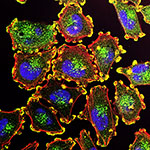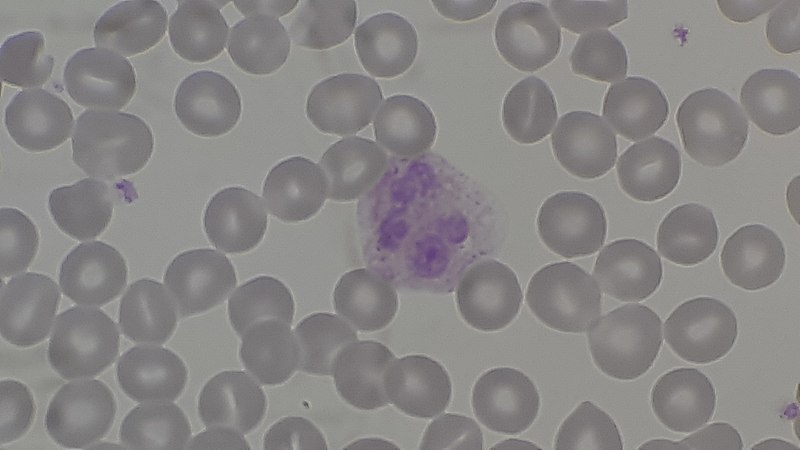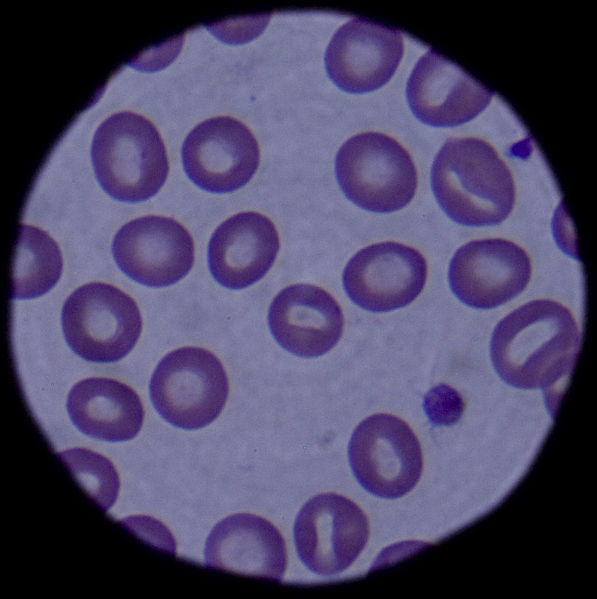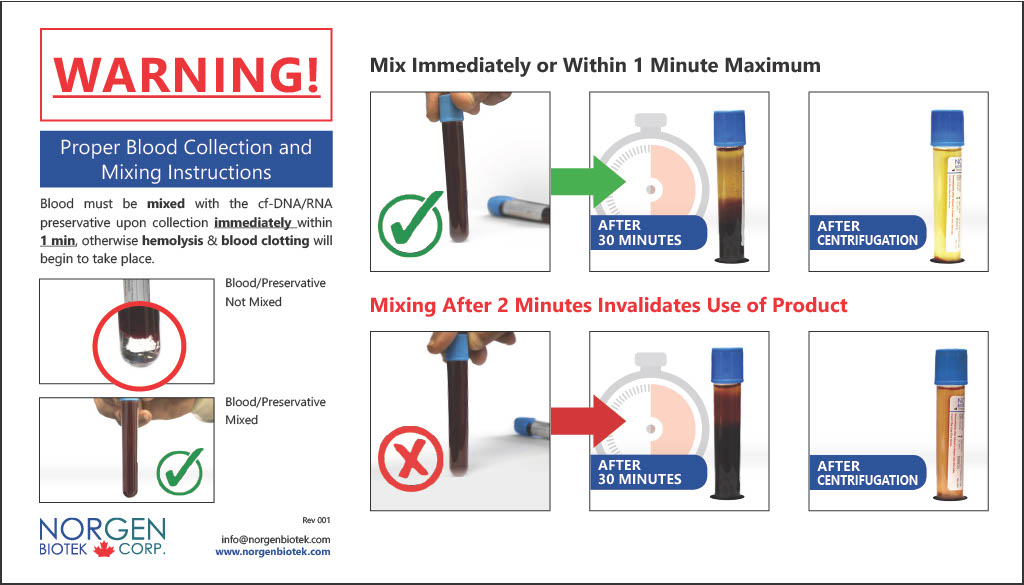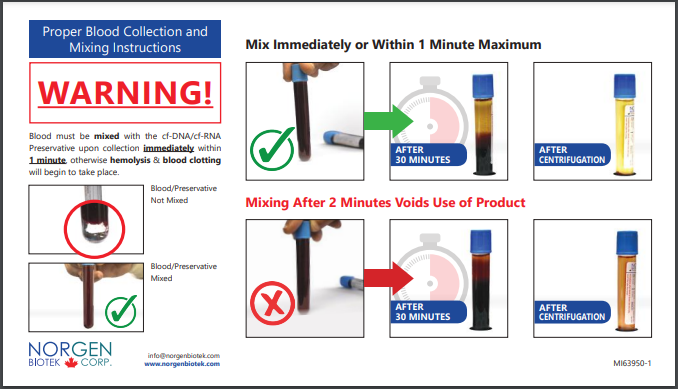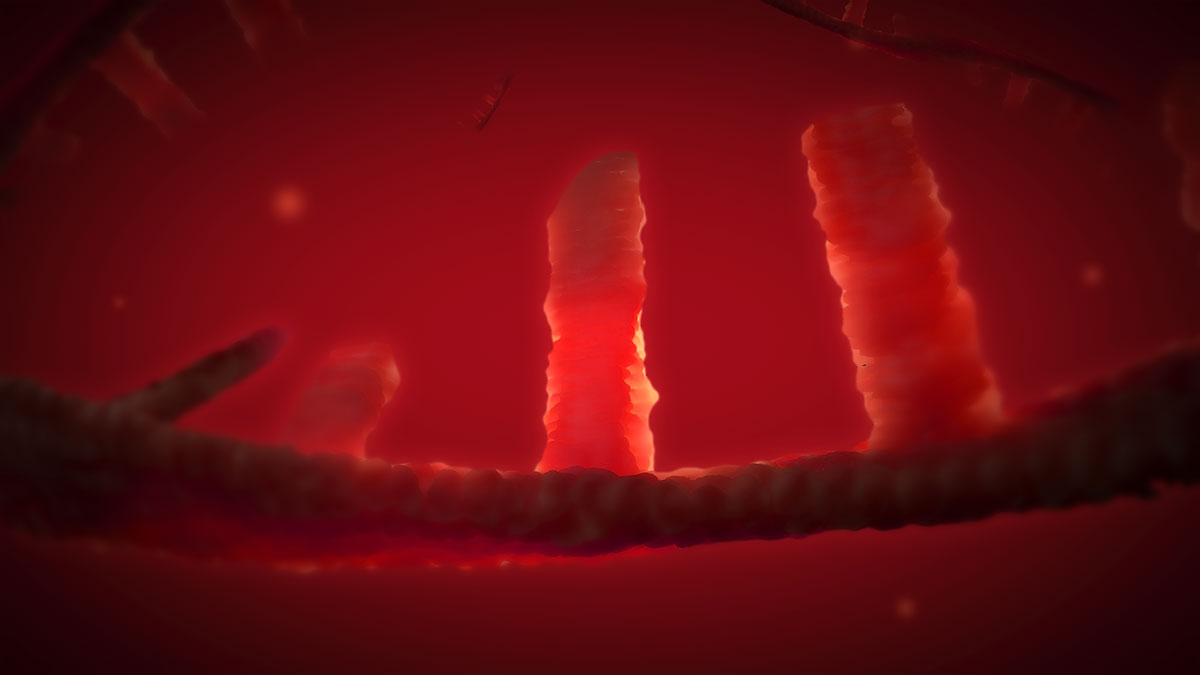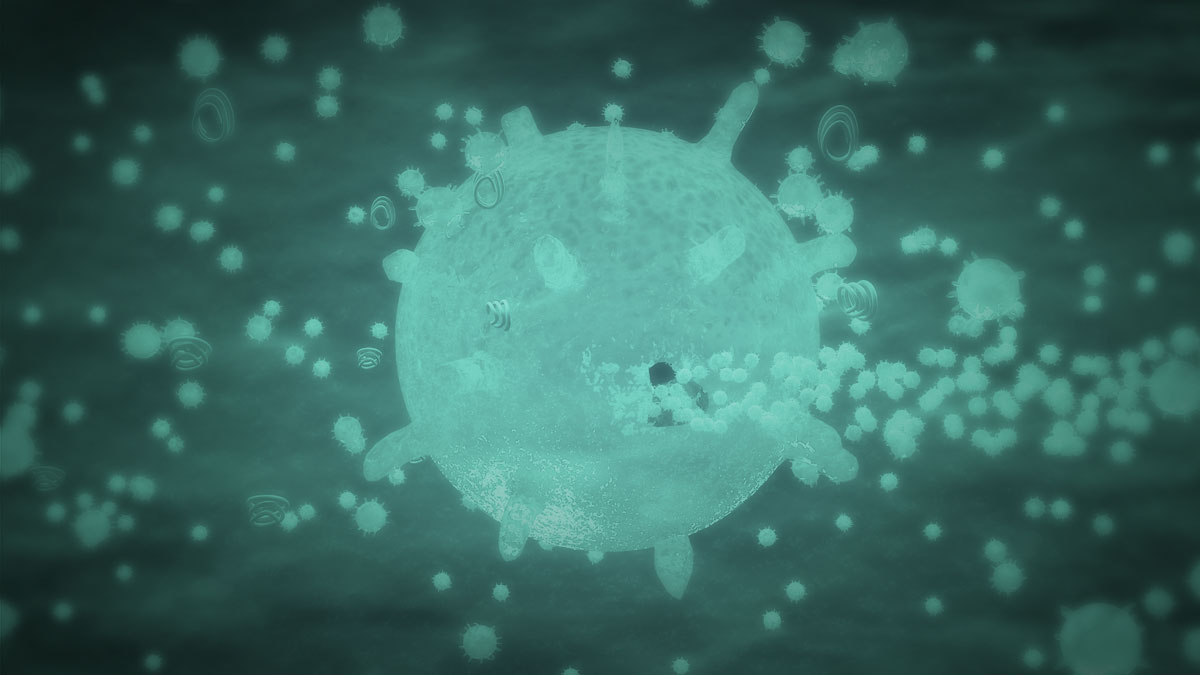Complete Plasma/Serum Workflow
cf-DNA/cf-RNA Preservative Tube
Collect your sample with the only tube that preserves & stabilizes both cell-free DNA (cf-DNA) and cell-free RNA (cf-RNA)
Featured Publication:
From Sampling to Sequencing: A Liquid Biopsy Pre-Analytic Workflow to Maximize Multi-Layer Genomic
Information from a Single Tube.
Explore the findings
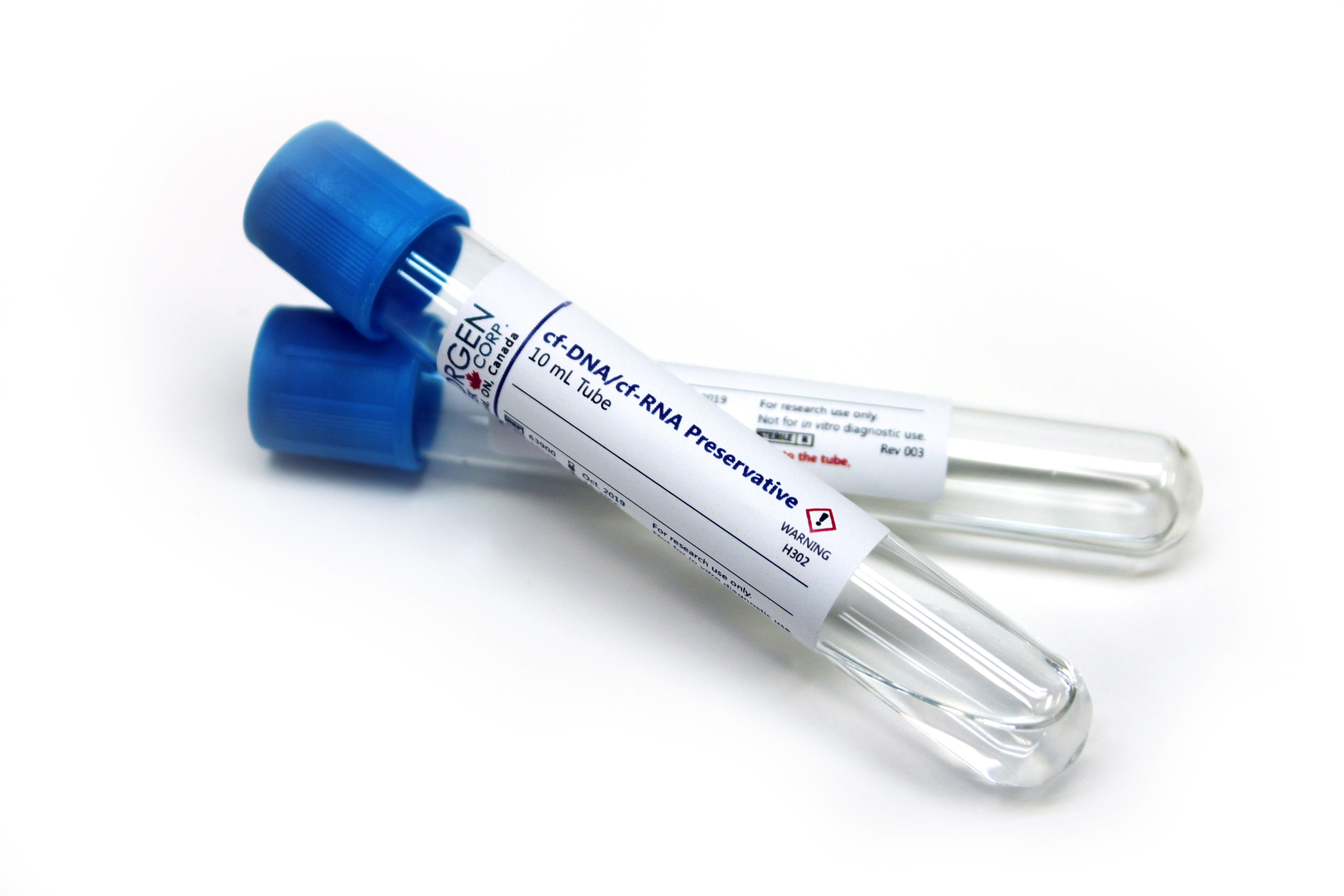
cf-DNA/cf-RNA Preservative Tube
Select each molecule to learn more about Norgen's unique tube and how it separates plasma from whole blood samples
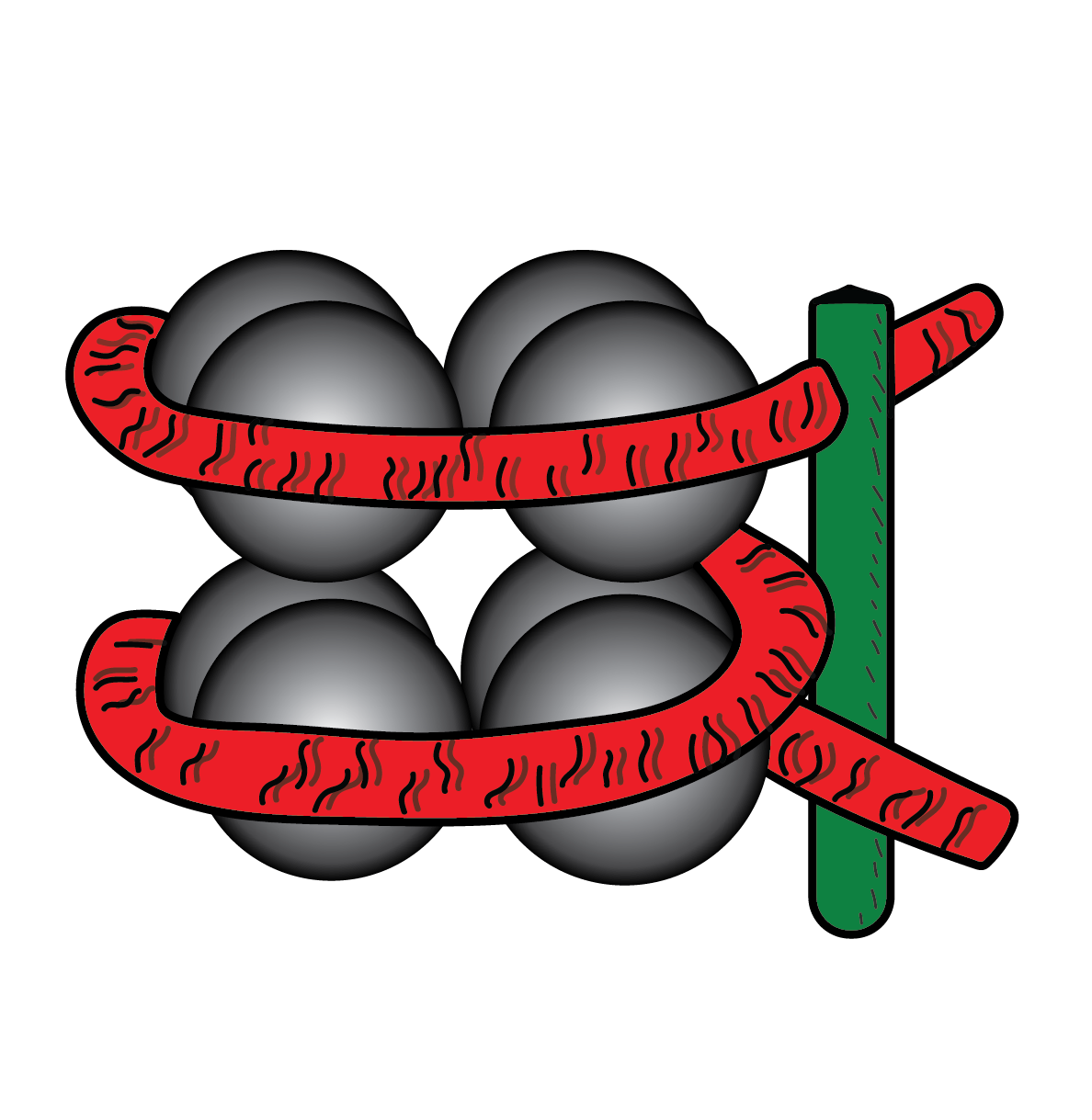 cf-DNA×
cf-DNA×
 cf-RNA×
cf-RNA×
 Exosomes×
Exosomes×
cf-DNA/cf-RNA Preservative Tube
Norgen's cf-DNA/cf-RNA Preservative Tubes provide an easy method of cf-DNA, cf-RNA and CTC preservation from whole blood samples, while also minimizing hemolysis during shipping and storage. The tubes provide cf-DNA and cf-RNA preservation for 30 days at room temperature, and CTCs preservation for 14 days at room temperature, with no cold-chain transportation or storage required. Purified cf-DNA and cf-RNA are compatible with any downstream application, including PCR, qPCR, rt-qPCR, gene expression analysis, microarrays and Next-Generation Sequencing.

cf-DNA
Cell-free DNA consists of small fragments of DNA that are found circulating throughout the body, outside of cells. Cell-free DNA is typically introduced into the bloodstream via apoptosis or necrosis (cell death) and is usually present in very low concentrations in plasma. While DNA released from cells is quickly degraded by nucleases in the blood, certain fragments that are bound to proteins or encapsulated in extracellular vesicles are protected from degradation and persist in circulation. Cell-free DNA encompasses a variety of subspecies, including circulating fetal DNA, circulating tumor DNA, and more.
Links

Cell-free RNA
Cell-free RNA, similar to cell-free DNA, refers to RNA circulating throughout the body outside of cells. Cell-free RNA is typically introduced into the bloodstream during cell death or during the active secretion of extracellular vesicles (in particular exosomes). While RNA is usually degraded by nucleases in the bloodstream, fragments that are bound to proteins (i.e. ribosomes and other proteins) or encapsulated inside exosomes are protected from degradation and remain in circulation. Once purified, cell-free RNA can be analyzed and used as a biomarker for various diseases and conditions.
Links
Circulating Tumor DNA
Circulating tumour DNA, also known as ct-DNA, refers to circulating DNA fragments that are either passively released into the circulation by the apoptosis or the necrosis of tumour cells or actively secreted into the circulation by live tumor cells. By examining mutations within the ct-DNA, or its methylation profile, ct-DNA can act as a key biomarker for the diagnosis and monitoring of cancer development.
Links
Exosomes
Exosomes are small extracellular vesicles released from cells throughout the body. They are typically between 40-150nm in diameter and act as cellular "messengers", carrying their cargo of proteins, lipids, and cell-free nucleic acids throughout the bloodstream to recipient cells. Since exosomes are released from a variety of cell types, including tumor cells, analyzing their content can provide unique biomarkers for various diseases.
Links
Circulating Tumor Cells
Circulating tumour cells (CTCs) are cells shed from a tumour into the circulatory system, and are often related to cancer metastasis. CTC analysis can provide important information about cancer prognosis and progression, and specific CTC tests are already clinically available. Norgen’s cf-DNA/cf-RNA preservative tubes stabilize CTCs for 14 days at room temperature for further downstream analysis.
Links
White Blood Cells
White blood cells, also called leukocytes, have an important role in the body’s immune defense. Like red blood cells, white blood cells can also burst during shipping and transport if not properly stabilized, releasing genomic DNA and RNA into the plasma. Norgen’s tubes ensure stabilization of white blood cells during transport and storage, and also allow for downstream recovery of leukocyte DNA and RNA.
Links
Red Blood Cells
Red blood cells are the most numerous type of blood cell, and give blood its characteristic red colour. If red blood cells undergo hemolysis (burst) during shipping and storage, they will release their content into the plasma or serum, causing issues with the downstream analysis of cell-free DNA and cell-free RNA analysis. Norgen’s preservation tubes provide best-in-class prevention of hemolysis during shipping and storage to ensure successful downstream purification and analysis of cell-free DNA and cell-free RNA.
Links
Features & Benefits
- Unique chemistry that preserves and stabilizes both cf-DNA and cf-RNA in a single tube
- Stabilize cf-DNA/ct-DNA/cf-RNA for 30 days and CTCs for 14 days at ambient temperature
- Stabilize cf-DNA/ct-DNA for 8 days at 37°C
- Fixative-free preservative - no cross-linking of DNA preventing bias in data analysis
- No plasma loss during transport
- Prevent hemolysis allowing highest quality plasma with no genomic DNA contamination
- Vacuumed PET (plastic) tubes to avoid breakage during shipping and transportation
- Minimize costs with full transcriptomic and genomic profiling from one tube
- High quality cf-DNA, ct-DNA, cf-RNA and exosomal RNA, compatible with a variety of downstream applications
Supporting Data
Figure 1. Effect of ambient temperature storage on cf-DNA (pDNA), exemplified by the short Alu (115bp) fragment, and genomic DNA (gDNA), exemplified by the large Alu (247 bp) fragment. Blood samples were drawn into either: 1) EDTA tubes, 2) Competitor tubes or 3) Norgen's cf-DNA/cf-RNA Preservative Tubes and stored at room temperature. Aliquots of blood were removed at the indicated times and the plasma was separated. DNA was isolated, and pDNA and gDNA concentrations were determined by real-time PCR using a short ALU gene target (115 bp) representing the pDNA and a long ALU gene (247 bp) representing the gDNA. Levels of these two fragments should stay the same for the duration indicating stabilization and no hemolysis. As expected, there was no stabilization of cf-DNA and extensive hemolysis in the EDTA tube. Competitor showed significantly lower Ct values for both genes after 14 days, whereas cf-DNA was stable for 30 days at room temperature for Norgen's cf-DNA/cf-RNA Preservative Tubes.
Figure 2. No plasma volume loss after shipping/transportation. Blood was drawn from 6 different donors in duplicate. One set was kept in the lab at room temperature and the other was packed in an insulated box and shipped from Thorold, ON via overnight air freight to Winnipeg, MB and then back to Thorold ON (elapsed time 72 h). Upon return, preserved samples were stored at room temperature for 7 days before plasma was separated. The plasma volume recovered from Norgen's cf-DNA/cf-RNA Preservative Tubes did not change before shipping or after shipping (6-7 mL recovered plasma). For both Competitor tubes and EDTA tubes the plasma volume recovered before shipping was ~ 4 mL and after shipping was ~ 2.5 mL.
Figure 3. Hemolysis of collected blood measured over time. Blood samples were drawn into: 1) EDTA tubes, 2) Competitor tubes and 3) Norgen's cf-DNA/cf-RNA Preservative Tubes and stored for up to 30 days. Hemolysis was determined by measuring the absorption of free hemoglobin in plasma from 3 subjects at 414 nm over several time points. Mean absorption is shown. The amount of free hemoglobin increased rapidly with each additional storage day in the EDTA tubes and Competitor tubes, and remained relatively constant in Norgen's cf-DNA/cf-RNA Preservative Tubes.
Figure 4. Prevent cell lysis and the release of gDNA and accumulation of apoptotic ladder in plasma. Blood samples drawn into three different tubes (Norgen's cf-DNA/cf-RNA Preservative Tubes, EDTA, and Competitor) and stored for up to 30 days. Norgen's cf-DNA/cf-RNA Preservative Tubes helps prevent the release of high molecular weight gDNA into plasma while also minimizing the accumulation of contaminating apoptotic ladder from dying peripheral blood leukocytes. As indicated in the black circle, gDNA contamination is at a very low level as compared to both the Competitor and EDTA tubes. This is indicative of very low levels of cell lysis and subsequent release of gDNA into the preserved plasma sample.
Figure 5. Effect of high temperature (37°C) storage for 8 days. Blood samples were drawn into either EDTA tubes, Competitor tubes or Norgen's cf-DNA/cf-RNA Preservative Tubes and stored at 37°C. cf-DNA was then isolated from processed plasma. gDNA concentration was determined by real-time PCR using a long ALU gene target (247 bp). The gDNA - target in EDTA tubes showed a significant drop in the Ct. value after 1 day of storage at 37°C compared to the initial time point, and continued to drop until the 8th day of storage. For Competitor, the gDNA - target remained stable up to the 4th day of storage and then the Ct. values started to significantly drop, indicating poor stabilization beyond day 4. Norgen's cf-DNA/cf-RNA Preservative Tubes stabilized samples for 8 days.
Figure 6. High Quantity of cf-DNA from Plasma preserved using Norgen's cf-DNA/cf-RNA Preservative Tubes. Blood samples from the same donor were drawn into either Competitor tubes or Norgen's cf-DNA/cf-RNA Preservative Tubes and stored at room temperature for 7 days. Norgen's cf-DNA/cf-RNA preservative Tube recovered 6.5mL plasma whereas the Competitor's tube recovered 3.5mL plasma. The cf-DNA was then isolated from the entire plasma volume recovered from each tube using Norgen's Plasma/Serum Cell-Free Circulating DNA Purification Midi Kit (Cat. 55600) and Norgen's Plasma/Serum Cell-Free Circulating DNA Purification Maxi Kit (Cat. 55800). The quantity of DNA recovered from both samples were assessed using the Agilent Bioanalyzer High Sensitivity DNA Chip. As can be seen in the Bioanalyzer trace, Norgen's preservative tube yielded more cf-DNA (Blue peak) as compared to the cf-DNA recovered from the Competitor's preservative tube.
Figure 7. Effect of ambient temperature storage on cf-RNA, exemplified by the 18S rRNA transcript, HPRT1 mRNA transcript and miR-21. Blood samples were drawn into either: 1) Competitor tubes or 2) Norgen's cf-DNA/cf-RNA Preservative Tubes. Competitor's tubes were stored at room temperature for 14 days whereas Norgen's cf-DNA/cf-RNA Preservative Tubes were stored for 30 days at room temperature. At the indicated times each tube was processed and the plasma was separated. Cf-RNA was isolated and the stability of the purified cf-RNA was determined by RT-qPCR amplification targeting the 18S rRNA transcript, HPRT1 mRNA transcript and miR-21. Levels of these three targets should stay the same for the duration indicating stabilization. Competitor showed significantly higher Ct values for the three targets after 7 days indicating cf-RNA degradation, whereas cf-RNA was stable for 30 days at room temperature for Norgen's cf-DNA/cf-RNA Preservative Tubes.
Figure 8. Effect of ambient temperature storage on plasma protein preservation for 30 days. Blood samples were drawn into Norgen's cf-DNA/cf-RNA Preservative Tubes and were stored for 30 days at room temperature. At the indicated times each tube was processed for plasma recovery and proteins were purified from 50 µL plasma using Norgen's ProteoSpin™ Abundant Serum Protein Depletion Kit (Cat. 17300). The stability of the purified A) depleted–plasma proteins and B) highly-abundant plasma proteins was evaluated on a 12% SDS-PAGE Gel. Both the depleted – plasma proteins and the highly abundant plasma proteins were found to be stable for 30 days at ambient temperature without any sign of protein degradation.
Isolate High Quality cf-RNA and cf-DNA from Plasma and Blood Samples
Use the interactive workflow to find the product right for you
Plasma/Serum
-
cf-DNA
-
Plasma/Serum cfc-DNA Purification Kits
Isolate all types of circulating DNA, including ct-DNA and fetal DNA
-
-
cf-DNA & cf-RNA
-
Plasma/Serum cfc-DNA/cfc-RNA Advanced Fractionation Kit
Isolate both cf-DNA and cf-RNA into two separate elutions
-
-
cf-RNA
-
Plasma/Serum RNA Purfication Kits
Isolate total cell-free RNA from the sample, including circulating and exosomal
-
-
Exosomes
-
Plasma/Serum Exosome and Free-Circulating RNA Isolation Kits
Isolate circulating RNA and exosomal RNA into two separate elutions
-
-
Plasma/Serum cfc-DNA Purification Kits
Isolate all types of circulating DNA, including ct-DNA and fetal DNA
-
Plasma/Serum Cell-Free Circulating DNA Purification Micro Kit
Input Vol: 10µL - 200µL
-
Plasma/Serum Cell-Free Circulating DNA Purification Mini Kit
Input Vol: 200µL - 500µL
-
Plasma/Serum Cell-Free Circulating DNA Purification Midi Kit
Input Vol: 1mL - 4mL
-
Plasma/Serum Cell-Free Circulating DNA Purification Maxi Kit
Input Vol: 5mL - 10mL
-
-
Plasma/Serum cfc-DNA/cfc-RNA Advanced Fractionation Kit
Isolate both cf-DNA and cf-RNA into two seperate elutions
-
Plasma/Serum cfc-DNA/cfc-RNA Advanced Fractionation Kit
Input Vol: 25µL - 50µL
-
-
Plasma/Serum RNA Purfication Kit
Isolate total cell-free RNA from the sample, including circulating and exosomal
-
Plasma/Serum RNA Purification Mini Kit
Input Vol: 50µL - 200µL
-
Plasma/Serum RNA Purification Midi Kit
Input Vol: 0.25mL - 1.5mL
-
Plasma/Serum RNA Purification Maxi Kit
Input Vol: 2mL - 5mL
-
-
Plasma/Serum Exosome and Free-Circulating RNA Isolation Kits
Isolate circulating RNA and exosomal RNA into two seperate elutions
-
Plasma/Serum Exosome and Free-Circulating RNA Isolation Mini Kit
Input Vol: 50µL - 1mL
-
Plasma/Serum Exosome and Free-Circulating RNA Isolation Midi Kit
Input Vol: 1mL - 4mL
-
Plasma/Serum Exosome and Free-Circulating RNA Isolation Maxi Kit
Input Vol: 4mL - 10mL
-
Plasma/Serum
-
cf-DNA
-
Plasma/Serum cfc-DNA purification Kits
Isolate all types of circulating DNA, including ct-DNA and fetal DNA
-
Plasma/Serum Cell-Free Circulating DNA Purification Micro Kit
Input Vol: 10µL - 200µL
-
Plasma/Serum Cell-Free Circulating DNA Purification Mini Kit
Input Vol: 200µL - 500µL
-
Plasma/Serum Cell-Free Circulating DNA Purification Midi Kit
Input Vol: 1mL - 4mL
-
Plasma/Serum Cell-Free Circulating DNA Purification Maxi Kit
Input Vol: 5mL - 10mL
-
-
-
cf-DNA & cf-RNA
-
Plasma/Serum cfc-DNA/cfc-RNA Advanced Fractionation Kit
Isolate both cf-DNA and cf-RNA into two seperate elutions
-
Plasma/Serum cfc-DNA/cfc-RNA Advanced Fractionation Kit
Input Vol: 1mL - 4mL
-
-
-
cf-RNA
-
Plasma/Serum RNA Purification Kits
Isolate total cell-free RNA from the sample, including circulating and exosomal
-
Plasma/Serum RNA Purification Mini Kit
Input Vol: 50µL - 200µL
-
Plasma/Serum RNA Purification Midi Kit
Input Vol: 0.25mL - 1.5mL
-
Plasma/Serum RNA Purification Maxi Kit
Input Vol: 2mL - 5mL
-
-
-
Exosomes
-
Plasma/Serum Exosome and Free-Ciruclating RNA Isolation Kits
Isolate circulating RNA and exosomal RNA into two seperate elutions
-
Plasma/Serum Exosome and Free-Circulating RNA Isolation Mini Kit
Input Vol: 50µL - 1mL
-
Plasma/Serum Exosome and Free-Circulating RNA Isolation Midi Kit
Input Vol: 1mL - 4mL
-
Plasma/Serum Exosome and Free-Circulating RNA Isolation Maxi Kit
Input Vol: 4mL - 10mL
-
-
Discover Norgen's NGS Services and Capture the Most From Your Samples
Next Generation Sequencing
Designed to Discover
Sequence Ultra-low Inputs from Plasma/Serum, Exosomes and More with Norgen's Small RNA-Seq Services.
- Capture a Complete Range of Small RNA and miRNA species
- Sequence Ultra-Low Inputs from Liquid Biopsies and Exosomes
- Illumina® NextSeq Sequencing Platform
- Understand Post-Transcriptional Regulation with Bioinformatics Analysis Service
- Examine Differential Expression and Discover Novel Biomarkers
- Fast Turn Around Time | 3 - 4 weeks
Featured Publications
| Featured | ||
| Title | From Sampling to Sequencing: A Liquid Biopsy Pre-Analytic Workflow to Maximize Multi-Layer Genomic Information from a Single Tube | |
| Journal | Cancers. June 2021. | |
| Authors | Kendra K. Maass, Paulina S. Schad, Agnes M. E. Finster, Pitithat Puranachot, Fabian Rosing, Tatjana Wedig, Nathalie Schwarz, Natalie Stumpf, Stefan M. Pfister and Kristian W. Pajtler | |
| Title | Response to BRAF/MEK Inhibition in A598_T599insV BRAF Mutated Melanoma |
| Journal | Case Reports in Oncology. 2019. |
| Authors | Sara Bjursten, Christoffer Vannas, Stefan Filges, Florian Puls, Ankur Pandita, Henrik Fagman, Anders Ståhlberg, and Max Levin |
| Title | Evaluation of Storage Tubes for Combined Analysis of Circulating Nucleic Acids in Liquid Biopsies |
| Journal | International Journal of Molecular Sciences. 2019. |
| Authors | Aoife Ward Gahlawat, Judith Lenhardt, Tania Witte, Denise Keitel, Anna Kaufhold, Kendra K Maass, Kristian W Pajtler, Christof Sohn, Sarah Schott |
| Title | 554P KRAS-dependent and independent mechanisms of progressive disease (PD) in colorectal cancer (CRC) patients (pts) with liver metastases (LM) while monitoring on circulating cell free DNA (cf-DNA) |
| Journal | Annals of Oncology. October 23, 2018. |
| Authors | A Kirov Z Mihaylova, V Petrova, T Todorov, D Petkova, A Garev, A Todorova-Georgieva |
| Documents | Poster |
| Title | Evaluation of commercial kits for purification of circulating free DNA |
| Journal | Cancer Genetics. 2019. |
| Authors | Russell J. Diefenbach, Jenny H. Lee, Richard F. Kefford, Helen Rizos |
Technical Documentation
- Assessing the Effect of Simulated Shipping on Cell-Free DNA in Blood Collected in Norgen, Streck and EDTA Tubes
- How to Preserve Cell-Free DNA and Prevent Cellular Genomic DNA Contamination in Plasma
- Plasma Exosomal microRNA Purification from Hitachi’s ExoComplete™ 96-Well Plate Kit
- Plasma/Serum Circulating and Exosomal RNA Purification Kit (Slurry Format) Effect of Microrna Gc Content On RNA Purification Efficiency
- Determining the Molecular Weight Cut-Off of Plasma Circulating DNA Using Two Commercially Available Kits
- Comparative Study of Plasma DNA Isolated Using Norgen’s Plasma/Serum Circulating DNA Kits Versus Qiagen’s QIAamp Kits
- Comparing Different DNA and RNA Quantification Methods for Biological Samples with Low Nucleic Acid Abundance
- Small RNA Sequencing of Plasma Exosomes Collected on Heparin: Quality and Quantity Challenges
- Revised Guidelines for RNA Quality Assessment for Diverse Biological Sample Input
- Proper Mixing Procedure
- 554P KRAS-dependent and independent mechanisms of progressive disease [...] monitoring on circulating cell free DNA (cf-DNA)
- Variation Between The Purification Efficiency of Microrna With Different Gc Content In Biological and Clinical Specimens
Contact the Experts
Get in touch with Norgen's on site product specialists for more information or a direct quote for the product you are interested in.
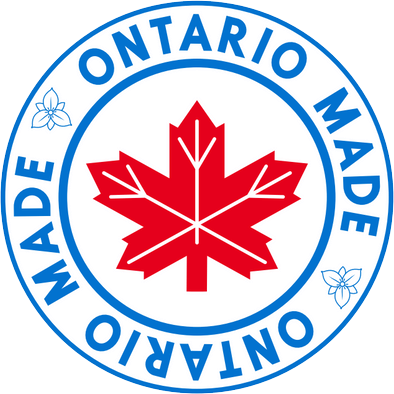

[Liquid Biopsy Workflow Success
Story]
Alex Rolland: Improving Cancer Diagnostics with Exosomal ct-DNA



